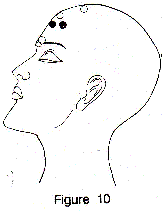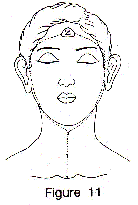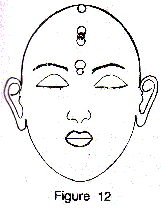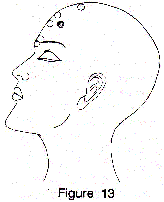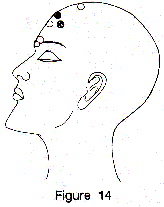PARA BRAHMAND MANDAL (REALM OF COSMIC CONSCIOUSNESS)
Eighth Knot: (Roots of Para Brahmand Mandal)This knot as observed above is a natural consequence of the earlier knot. The powers and the charm displayed by jnana of the 7th knot leads to a state of relative disinterestedness in self and the realm of God is appreciated better. All the time awareness of the Master as the object to be sought develops in oneself total resignation to the will of God and feelings of everything is Divine play gets rooted deep in the core of being. This detachment may perhaps be called as the pinnacle of what is termed by the vedantins as uparati. While the detachment or Vairagya that is experienced at the pind desh may approximately be described as "I do not seem myself to be of any value" and is mostly an experience of one's own irrelevance to the scheme of things experienced in the Brahmand it is experienced as "irrelevance of anything in the world" and a feeling that everything is either a drama or play and there is no value for anything. "The world is a dream" is the feeling here while earlier it is "I am in a dreamy world".
The feeling of this refined phase of detachment or Vairagya however does not in any way affect the calmness or peace which is the essential nature of this knot. There is of course no colour that is observed here normally. However, it is likely that grey or ruby colour is seen if not rubies. This is due to the fact that from here onwards the realm of the Divine proper starts. This is the realm of the Para Brahman. Master warns that if any one tries to cultivate this feeling of "that the world is a dream" artificially it will only impede progress. This obviously is a warning to the philosophers (Vedantins) who actually advocate such a thinking process so that such a condition may actualise itself. He says such an attempt will only be deceptive in nature. The psychological state here is compared by Master to be similar to the state "we feel a sort of freshness like that which a sun-stricken person would feel after a cool bath in the river in hot summers". This obviously refers to the condition of the soul in bondage so far and a sense of liberation that is felt by the aspirant from now onwards. CHIT LAKE:
The Great Master says "If anybody wants to search out the ocean in the human body, it is the chit lake - the point marked Z (in the Figure 11). The vibrations are there and Nature regulates them. It has no concern with the Ajna chakra. The Ajna chakra has some other purpose. It only distributes the power and energy for the consumption of the human organism while thought force works in the chit lake. There are different colours found in the people of different mentalities. The grey is the medium colour of an ordinary human being who has risen a little higher. In the case of a perfect human being the colour of the chit lake in the end turn to that of ruby. The ruby colour was discovered by Dr. K. C. Varadachari at Tirupati by his observations and it is entirely correct." The shade of the colour is difficult to express but the realm of colourlessness starts from here onwards. The vibrations of the chit lake become very low as and when it is thoroughly cleaned and state of calmness or deep quiet is almost similar to the condition of void or sunya. However, to bring the chit lake into moderation is not that easy and persistent labour is required. The chit lake the Master says can be easily cleaned if we clean the right toe. He suggests a direct association between the tip of the toe and the chit lake. The connection between the chit and the right toe is also suggested in tradition in the natha cult of yoga and more particularly the Jnanadeva order. The right toe itself is called kala pada. The point to note, however, is that the chit or consciousness has to be cleaned thoroughly and it should come to its original state. The original state of chit is its total attention to the Divine and its perverted or inverted form is attention to manifestation of the Divine. Saraswathi Centre:
Abutting this knot is the centre of Saraswathi which is the centre of higher wisdom. (The great Master located this knot just about 3 finger width above the mid of eyebrows in the case of the author) (Fig 12 and 13). The Saraswathi centre is only in the Brahmand and is not above this realm. As a matter of fact all knowledge in the ordinary sense ceases by the time Brahmand is crossed. Revered Master in Silence Speaks (p.467-2004 ed) makes a categorical statement that both the Chit Lake and Saraswathi centre are in Brahmand. This centre is the one that is referred in the Vedic mantras to have direct connection with the control of sex and sensual organs. This centre is also the place where there is a record of actions and reactions in past lives as samskaras. The abhyasi traversing this region generally feels intense craving for sensual pleasures and dreams and thoughts related to these are frequent. The abhyasi gets disturbed over this and naturally seeks the Divine help to get rid of these. However, it is wiser to ignore them and proceed with the confidence that the Master's support is there always. By the wisdom of surrendering oneself to the Master that has by now become natural for the aspirant, he crosses the realm of experiences and the realm of imperience starts.
So far there is always an awareness of the Divine being something "other" than oneself and from now onwards the duality starts diminishing. The realm of nothingness starts from here and the first stage of this is the condition of surrender in the real sense of the term. Ninth knot: The region of the heart finally comes to its finest aspect in the realm of Para Brahmand. The heart on which we have been meditating has now turned totally divine and the Atma chakra has taken the lead. All the perceptions and approaches to all aspects of life now take the colour of "greater self" which is really the governing principle in life. Real life starts. The feeling of humility or prayerfulness as Master calls it dominates all the perceptions. The capacity to be always in a state of prayer is what is developed here fully. The feeling that the aspirant is a true servant and he is approaching the great Master in the humble capacity of an insignificant beggar gets engrossed in his mind. He puts up everything before his Master, resigning himself completely to His will. In other words he assumes his real form after surrendering everything to the Master. He withdraws himself from all sides and turns completely towards Him losing all worldly charms. There is absolutely no other form of remembrance than the remembrance of the Lord and the process of negation starts. When the remembrance of the Master finally turns into a state of pulsations and vibrations felt through the entire system of body and mind one can be said to have reached the pinnacle of negation. The movement between the two states mentioned above is the dynamic movement of soul in its journey to infinite in the sphere of Para Brahmand. When the second stage mentioned above reigns supreme it may be taken as total annihilation of self. In this state he will never turn towards anything that is against the Divine will. His mind will always be directed towards that which is the Master's command. This is entirely different from the state of surrender the Aspirant felt in the knot 4. The Master says this is the real state of prayer. He is an embodiment of prayer. Then his thoughts will be synonymous with that of the Master.
This stage is to be established firmly for any higher progress. The aspirant does not concern himself with the means of realisation here but his thoughts are fixed on the goal or the Master and all his energies are directed for the attainment thereof. Service to the Master with total dedication, commitment and utilisation of all of one's reserves is the attitude he develops. Here in fact the Master does not appear to be the goal and service the means but the means and goal seem to be the service itself. In order to stabilise in the region certain pitfalls are to be avoided. This in fact is the reason certain fundamentalist approaches are adopted and advocated in religions: which of course is not necessary. The world appears here as neither a reality nor a non-reality and total dependency on the Master develop. This is a logical consequence of incapacity to judge any issue and the reality of the Master is the only certain thing the aspirant is aware of. In this state the aspirant surrenders himself to the care of the Master even as the cows surrender to the will of the shepherd. This is the symbolism that is expressed in the concept of Gopala or Pasupathi. The aspirant has no will of his own and is entirely dependent on the will of the Master and will do His bidding and will be guided by Him in all matters. While in the sphere of the Brahmand the self or the individual is the focus of attention and it is only its expansion that is experienced in all its brilliance, the Para Brahmand is characteristically non-self awareness and it is exclusive attention or orientation to the Divine. The process of expansion of self which commences right from the point of atman reaches its full expression in Brahmand and the process of self-negation which commenced in the 4th knot in Pind desh attains its finer state with the beginning of Para Brahmand and this self-negation or fana reaches its pinnacle by the time the aspirant reaches the stage of consciousness of the Mind region. The region of this knot starts just above 3 finger width above the Trikuti almost abutting the point of Saraswathi referred to above. (Figure 14) From now onwards the impression of the self or the atman in the thought process ceases and everything carries with it a tinge of the Divine touch. Each and everything is perceived as the Godly expression and reverence to all develops automatically without of course the emotional tinge. The great Master says from here the contact with Bhuma starts. This is the beginning of life in the Brighter world in the real sense of the term and the soul is reborn. The cradle of Divinity swings lightly here and the refreshing breeze of the Divine leaves the aspirant move and have his being in the consciousness of the divine. Constant remembrance is now not an effort but is something that is natural to one's consciousness. The awareness of the Divine is a very important transformation in consciousness that takes place here. Here the aspirants feel the negative aspect of Vairagya and the positive aspect of the awareness of the Lord. Because all the previous knots are somehow or the other related to manifestation or nature or can be said to be alloyed with matter (either in its distributive or exhibitive aspect) this awareness of the intimacy with Lord was not all that possible till the aspirant reaches this stage of consciousness. The feeling of the presence of the Lord develops into an unconscious and continuous worship. He is the Master and I am His slave is the predominant feeling. A deep reverential consciousness prevails in every walk of life. This is also called as Prapanna gati. |
|


